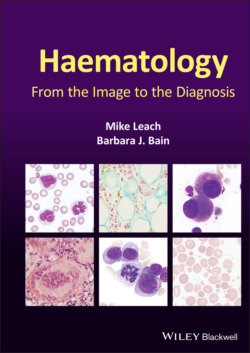Читать книгу Haematology - Barbara J. Bain, Irene Roberts - Страница 31
Оглавление22 Infantile osteopetrosis
A 6‐month‐old boy, born to consanguineous parents, presented with failure to thrive, developmental delay and pancytopenia. He was found to have significant hearing impairment. His full blood count showed Hb 80 g/l, WBC 2 × 109/l, neutrophils 0.8 × 109/l and platelets 50 × 109/l. The blood film was leucoerythroblastic but abnormal cells were not identified. The bone marrow aspirate was markedly hypocellular. The bone marrow trephine biopsy sections were highly abnormal, showing prominent disorganised trabecular structure and whorls with a significant encroachment on, and reduction in activity of, normal haemopoietic marrow (top images ×10 objective, bottom images ×50). The normal haemopoietic marrow space appears overrun by abnormal disorganised marrow trabeculae. The clinical presentation and marrow findings are indicative of inherited infantile osteopetrosis.
Infantile osteopetrosis is a serious autosomal recessively inherited disorder of osteoclast malfunction. It presents in infancy with progressive pancytopenia and cranial nerve compromise due to uncontrolled bony overgrowth resulting from an osteoclast‐based remodelling failure. The most serious early consequences are progressive hearing and visual loss due to compression of the auditory and optical nerves, respectively. The condition needs to be recognised and treated early since, as osteoclasts are derived from bone marrow stem cells, the only effective therapy is allogeneic bone marrow transplantation.
The images above are plain X‐rays of the pelvis in a child with osteopetrosis before (left) and after (right) allogeneic stem cell transplantation.1 Note the marked improvement in bone density due to the donor‐derived stem cells and subsequent osteoclast‐related bone resorption and remodelling. The transplant also helps re‐establish the haemopoietic marrow space and thus blood count recovery.
MCQ
1 Infantile osteopetrosis can be associated with:Autosomal recessive or dominant inheritanceDecreased osteoclastsFragile bonesResponsiveness to vitamin D that renders transplantation unnecessaryIncreased osteoclastsFor answers and discussion, see page 206.
Note
1 1 Images courtesy of Professor Rob Wynn and Cambridge University Press.
